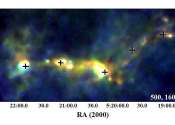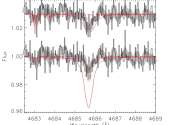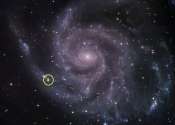Last update:
Astronomy news
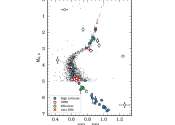
Recently discovered black hole is part of a nearby disrupted star cluster, study finds
European astronomers have investigated a recently detected black hole designated Gaia BH3. In their results, they found that the black hole is associated with a nearby disrupted star cluster known as ED-2. The finding is ...

NASA's Chandra releases timelapse movies of Crab Nebula and Cassiopeia A
New movies of two of the most famous objects in the sky—the Crab Nebula and Cassiopeia A—are being released from NASA's Chandra X-ray Observatory. Each includes X-ray data collected by Chandra over about two decades. ...
Astronomy
Apr 24, 2024
0
55

See the Southern Ring Nebula in 3D
Planetary nebula are some of nature's most stunning visual displays. The name is confusing since they're the remains of stars, not planets. But that doesn't detract from their status as objects of captivating beauty and intense ...
Astronomy
Apr 24, 2024
0
40

International team detects eruption of mega-magnetic star in nearby galaxy
While ESA's satellite INTEGRAL was observing the sky, it spotted a burst of gamma-rays—high-energy photons—coming from the nearby galaxy M82. Only a few hours later, ESA's XMM-Newton X-ray space telescope searched for ...
Astronomy
Apr 24, 2024
0
58

Black hole 'traffic jams' discovered in galactic centers by astronomers
An international study, led by researchers from Monash University, has revealed crucial insights into black hole dynamics within massive disks at the centers of galaxies.
Astronomy
Apr 24, 2024
0
44
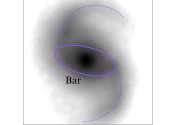
Star bars show universe's early galaxies evolved much faster than previously thought
The universe's early galaxies were less chaotic and developed much faster than previously thought, according to new research looking back more than ten billion years in time. An international team of astronomers led by Durham ...
Astronomy
Apr 23, 2024
0
60

Hubble celebrates 34th anniversary with a look at the little dumbbell nebula
In celebration of the 34th anniversary of the launch of NASA's legendary Hubble Space Telescope on April 24, astronomers took a snapshot of the Little Dumbbell Nebula (also known as Messier 76, M76, or NGC 650/651) located ...
Astronomy
Apr 23, 2024
0
36

Astrophysicists work toward unification of turbulence framework—weak-to-strong transition discovered in turbulence
Turbulence is ubiquitous in nature. It exists everywhere, from our daily lives to the distant universe, while being labeled as "the last great unsolved problem of classical physics" by Richard Feynman. Prof. Dr. Huirong Yan ...
Astronomy
Apr 23, 2024
0
247

MeerKAT: The South African radio telescope that's transformed our understanding of the cosmos
South Africa's Karoo region is a vast semi-arid area that stretches across four of the country's provinces. It is sparsely populated and renowned for its wide open spaces.
Astronomy
Apr 23, 2024
0
51

A first glimpse at our galaxy's magnetic field in 3D
Thanks to new sophisticated techniques and state-of-the-art facilities, astronomy has entered a new era in which the depth of the sky can finally be accessed. The ingredients of our cosmic home, the Milky Way galaxy—stars, ...
Astronomy
Apr 23, 2024
0
64

New JWST observations reveal black holes rapidly shut off star formation in massive galaxies
New research published in Nature showcases new observations from the James Webb Space Telescope (JWST) that suggest black holes rapidly shut off star-formation in massive galaxies by explosively removing large amounts of ...
Astronomy
Apr 23, 2024
0
304
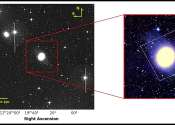
Observations explore globular cluster system in the galaxy NGC 4262
Using the Canada-France-Hawaii Telescope (CFHT), Indian astronomers have performed wide and deep field observations of a polar ring galaxy known as NGC 4262. Results of the observational campaign, published April 15 on the ...
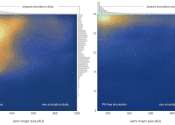
New evidence found for Planet 9
A small team of planetary scientists from the California Institute of Technology, Université Côte d'Azur and Southwest Research Institute reports possible new evidence of Planet 9. They have published their paper on the ...

Researchers detect a new molecule in space
New research from the group of MIT Professor Brett McGuire has revealed the presence of a previously unknown molecule in space. The team's open-access paper, "Rotational Spectrum and First Interstellar Detection of 2-Methoxyethanol ...
Astronomy
Apr 23, 2024
0
847

Q&A: Cosmic rays, space weather and larger questions about the universe
With the naked eye, you can't see the weather in space, or feel the cosmic rays beaming down to Earth—but they can impact critical systems like our climate, computer connectivity, communications and even our health.
Astronomy
Apr 22, 2024
0
7

Eclipse projects shed new light on solar corona
Teams led by Southwest Research Institute successfully executed two experiments—by land and air—collecting unique solar data from the total eclipse that cast a shadow from Texas to Maine on April 8, 2024. The Citizen ...
Astronomy
Apr 22, 2024
0
17

Astrophysics research advances understanding of how gamma-ray bursts produce light
Gamma-ray bursts (GRBs) are intense bursts of gamma radiation, typically generating more energy in a few seconds than the sun will produce over its ten-billion-year lifetime. These transient phenomena present one of the most ...
Astronomy
Apr 22, 2024
0
1288

Doomed comet spotted near the sun during the April 8 total solar eclipse
A surprise appearance of a new comet made the April 8 total solar eclipse all the more memorable.
Astronomy
Apr 22, 2024
0
60

Hubble captures a bright galactic and stellar duo
This image from the NASA/ESA Hubble Space Telescope features NGC 3783, a bright barred spiral galaxy about 130 million light-years from Earth that also lends its name to the eponymous NGC 3783 galaxy group.
Astronomy
Apr 22, 2024
0
66

AI and physics combine to reveal the 3D structure of a flare erupting around a black hole
Scientists believe the environment immediately surrounding a black hole is tumultuous, featuring hot magnetized gas that spirals in a disk at tremendous speeds and temperatures. Astronomical observations show that within ...
Astronomy
Apr 22, 2024
0
639
Other news

Demonstration of heralded three-photon entanglement on a photonic chip

Managing meandering waterways in a changing world

How much trust do people have in different types of scientists?

Freeze casting—a guide to creating hierarchically structured materials

Advanced cell atlas opens new doors in biomedical research

Airborne single-photon lidar system achieves high-resolution 3D imaging






















































